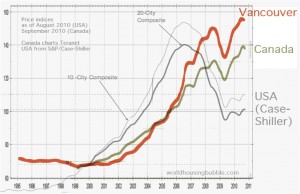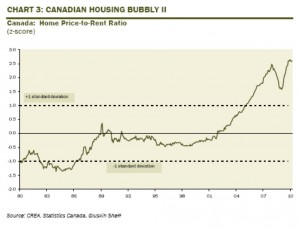Timing & trends
Within the last month: Central banks in Asia, Europe and America have launched new “Q” policies of one kind or another and “risk assets” were bid higher. Gold jumped $200 from its mid-August lows, the DJI and the TSE each rallied over 600 points with the Dow hitting a 5 year high. The US Dollar fell and all other currencies rallied with the C$ trading above 103.5 for the first time in 13 months…up 8 cents from its summer lows. WTI Crude briefly spiked above $100 for the first time in 4 months.
My short term view: We’ve had a “blow-off” top in risk assets on the back of this latest round of “Q.” I think the “sugar rush” of “easy money” swung the Teeter-Totter of Market Psychology too far, too quickly, and that stocks, commodities and currencies will fall (are falling) from their recent highs.
Gold: I’m neutral on gold…although it will likely weaken if stocks and commodities fall and particularly if the US Dollar rises…but gold is the best hedge against Central Banks and governments getting out of control with their reflationary efforts…gold is at all-time highs Vs. the Euro and Swiss franc…the volume of outstanding Gold ETFs are at all-time highs…that makes me unwilling to be a buyer…if I really wanted to buy gold I’d buy it against stocks and commodities. I remain short WTI crude as it appears to be the weakest of the “risk assets.” (In mid-August 1 oz. of gold = ~17 barrels, now 1 oz. of gold = ~19 barrels.)
Market Psychology: My short term view is negative because I expect a swing in the Market Psychology Teeter-Totter. Monetary and fiscal authorities around the world have just thrown more fuel on the fire in their fight against private sector deleveraging…and the Teeter-Totter of Market Psychology swung in the direction of “risk on” because of their reflationary efforts…but I now expect it to swing the other way as the bullish exuberance wears off…and is replaced by worries about global fiscal and economic problems.
The inflation/deflation question: The Fed certainly seems determined to “break the back” of deflation and the “gold bugs” are convinced that we will have inflation and that gold prices will soar as the Fed and other central banks try to “print” their way out of deflation. The Fed wants to increase employment…they want to get consumers spending again…they want to create a “little” inflation and are convinced that they can keep it under control if they get it started.
My fellow North Americans are probably pre-disposed to expect inflation rather than deflation in their future…although the long-term unemployed may disagree. Inflation is easier to understand…it’s what we’ve grown up with…to most of us it means rising asset prices and we see that as a good thing…we want to believe that the Authorities can “fix” the deleveraging problem…just as we want to believe that the right Government can “fix” our economic and social problems.
Looking at the inflation/deflation question from a longer term perspective I expect that the deflationary trends produced by global deleveraging will be powerful and persistent…I expect that the central bankers understand that and see the latest round of “Q” as just one more battle in a long running war.
Ed Note: Victor has a great section on his website on what’s below HERE
These messages are taped to my trading screens:
- WAY MORE MONEY HAS BEEN BORROWED THAN WILL EVER BE REPAID
- WAY MORE PROMISES HAVE BEEN MADE THAN WILL EVER BE KEPT
- WHY DO YOU BELIEVE WHAT YOU BELIEVE?
- YOU GOTTA GET YOUR MIND RIGHT
- ANYTHING CAN HAPPEN
- MONEY IS SIMPLY TRANSFERRED FROM ONE PERCEPTION TO ANOTHER
- TRADE THE SAME TIME FRAME AS YOUR ANALYSIS
- EXACTLY WHAT ARE YOU TRYING TO TRADE?
- IT’S NOT A GAME OF PERFECT
- EVERYTHING NEEDS TO BE HEDGED
- ITS ONLY A TRADE
- ARE YOU TRADING WHAT YOU THINK THE MARKET SHOULD BE DOING…..OR WHAT IT IS DOING?
- Victor’s 22 Absolutely Essential Rules for Trading
- An excelllent trading lesson from Dennis Gartman – October 2011
- Black Swan Currency Trading – Courtesy of Jack Crooks
- Gartman’s Trading Rules – Courtesy of Dennis Gartman
- 1985 Interview with trading legend Roy Longstreet from Intermarket Magazine
- Know What You Don’t Know – Thoughts from Trading Master PAUL TUDOR JONES with comments from Dennis Gartman
- Bob Farrell’s Ten Market Rules – With comments from Dennis Gartman
- Keeping It Simple – by Black Swan Currency Trading August 29, 2008
- Sitting Tight – From Reminiscences of a Stock Operator – by Jesse Livermore
- www.HardAssetsInvestor.com interviews Victor Adair – May 2008
- “It’s not a question of enough, Pal. It’s a zero sum game, someone wins, someone loses. Money itself isn’t lost or made, its simply transferred from one perception to another.” – Gordon Gekko, Wall Street, 1987

About VICTOR ADAIR
Senior Vice President and Derivatives Portfolio Manager
Victor Adair is a Senior Vice President and Derivatives Portfolio Manager at Union Securities Ltd. Victor began trading financial markets over 40 years ago and has held a number of senior positions during his long career as a commodity and stockbroker. He provides daily market commentary on CKNW AM 980 radio Vancouver and is nationally syndicated on Mike Campbell’s weekly Moneytalks radio show.
Victor’s trading focus is primarily on the currency, precious metal, interest rate and stock index markets and his clients are high net worth individuals and corporations.
Victor Adair is a Senior Vice President and Derivatives Portfolio Manager at Union Securities Ltd. Victor began trading financial markets over 40 years ago and has held a number of senior positions during his long career as a commodity and stockbroker. He provides daily market commentary on CKNW AM 980 radio Vancouver and is nationally syndicated on Mike Campbell’s weekly Moneytalks radio show.
Victor’s trading focus is primarily on the currency, precious metal, interest rate and stock index markets and his clients are high net worth individuals and corporations.
Does Canada have a housing bubble? It is a common question these days and based on some simple analysis of aggregate data on current prices versus long-term historical averages, rents and income the answer for certain markets would appear to be yes. However, there is considerable variation by local market as to the degree by which houses have deviated from long-term averages – a few more years of ZIRP by the Bank of Canada and that remains to be seen.
I would put limited credence on the metric most favoured by housing cheerleaders – affordability as measured by mortgage rates – as interest rates are at historic lows and ultimately a house is a long-term consumption good and long-term income levels must dictate prices.
House Prices versus Income (click on charts for larger version)
House Prices versus Rental Costs
House Prices versus Historical Averages
Of course some markets are better than others, but certainly the key, large markets seem stretched as can be seen in recent research by Demograhia:
“Historically, the Median Multiple has been remarkably similar in Australia, Canada, Ireland, New Zealand, the United Kingdom and the United States, with median house prices having generally been from 2.0 to 3.0 times median household incomes (historical data has not been identified for Hong Kong), with 3.0 being the outer bound of affordability. This affordability relationship continues in many housing markets of the United States and Canada. However, the Median Multiple has escalated sharply in the past decade in Australia, Ireland, New Zealand, and the United Kingdom and in some markets of Canada and the United States.
Housing in Canada is moderately unaffordable with a Median Multiple of 4.6 in major metropolitan markets and 3.4 overall. Housing was generally affordable in Canada as late as 2000. In the early years of the Demographia International Housing Affordability Survey, Canada was generally the most affordable nation. However, this year, Canada ranks third, behind the United States and Ireland.
Among major markets, four were moderately unaffordable and two were severely unaffordable. Among all markets, 9 were affordable, 17 were moderately unaffordable, 3 were seriously unaffordable and 6 were severely unaffordable. The four most unaffordable metropolitan markets were in British Columbia (Table 7).
Edmonton was the most affordable major market, with a Median Multiple of 3.5, while Ottawa-Gatineau had a Median Multiple of 3.7. Both of these markets were rated moderately unaffordable.
Canada’s most affordable markets were Windsor (ON) at 2.2, Fredericton (NB) at 2.4, Moncton (NB) at 2.5. Other affordable markets were Saint John (NB) and Thunder Bay (ON) at 2.6. Yellowknife (NWT) and Charlottetown (PEI) at 2.9 and Saguenay (QC) at 3.0 and Trois-Rivieres (QC) at 3.0.
Vancouver, which like Sydney has largely prohibited housing development on the urban fringe for decades, experienced a significant deterioration, with housing reaching a Median Multiple of 10.6, replacing Sydney as the second most unaffordable market in the Survey, following Hong Kong. Toronto was also severely unaffordable, at 5.5, a deterioration of 40 percent in housing affordability since 2004, as that metropolitan area’s “smart growth” program has taken effect. Montreal has been one of the worst performers in housing affordability, over the years of the Demographia International Housing Affordability Survey, with a Median Multiple of 5.1, up nearly 60 percent from 2004, at the same time as the land for development has been severely limited by an inflexible approach to agricultural zoning. Smaller British Columbia markets Abbotsford (7.0), Victoria (6.6) and Kelowna (6.6) were also severely unaffordable.”
House prices are highly mean reverting to median income and it is on that metric that most markets seem stretched. The timing and path of trend changes are always challenging to predict – are we facing an imminent and sharp price adjustment or a long, drawn out malaise. Perhaps the relentless upward march will continue?
Stephen Johnston
We are continuing to see a rather tight but volatile market, with all the markets literally coiling up in springs. It’s highly unusual for the September period to see such sideways, but volatile, tightening trading markets with volume in most markets literally falling off a cliff.
Ed Note: To watch it on video go HERE
So, I continue to be very certain that we are on the cusp of very big moves in many markets. And most likely, those moves will not be the moves you’ve seen recently.
I still remain bearish on gold, looking for a top in the stock market, and looking for a bottom in the dollar.
We are getting close to the point where there would be the potential for me to reverse those opinions, but we are not there yet. And I remain (convinced) with what my models are saying — which is to look for a top in gold, look for a top in stocks, and look for a bottom in the U.S. dollar.
Gold: As I wrote recently and you can see here on this chart, even (with) the latest rally — which occurred over Thursday and Friday of last week — gold has yet to take out its March 2012 high or its November 2011 high.
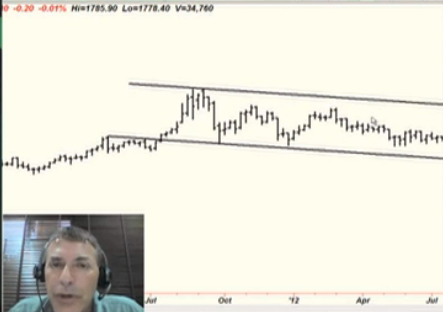
And given all the money-printing that’s going on — with China jumping in on the fray this past week — that’s pretty amazing.
That’s a subtle sign that we may be reaching a top here, and all this money-printing is not going to be the catalyst that sends gold to new record highs.
Ultimately, it will be — it was in the first phase of gold’s bull market. But we may have to wait for gold to really take off until the sovereign-debt crisis hits the United States. That’s the big atom bomb for the financial markets.
And we are not there yet. Most of the sovereign-debt worries are still, of course, focused on Europe.
Silver: Silver is pretty much the same. Silver hasn’t broken out yet despite all this money-printing. That’s somewhat not surprising because silver is more of an industrial metal; but nevertheless, silver has not broken out yet.
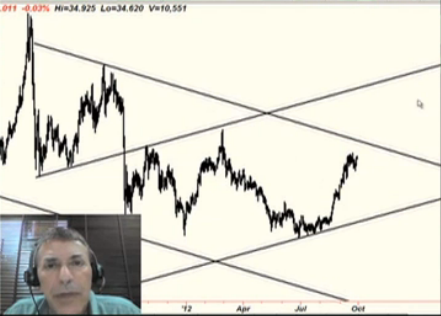
U.S. Dollar Index: The dollar is indeed trying to find a bottom in here. I believe it certainly will very soon. The euro has sold off rather sharply last week, and that’s lending support to the dollar. I’m starting to get some preliminary buy signals in the short- and intermediate-term for the dollar, so please stay tuned to my work there.
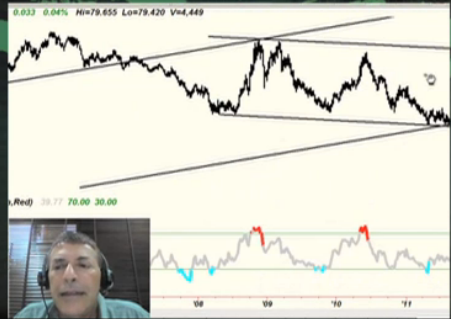
Dow Industrials: The Dow Industrials are starting to show some signs of weakness. This is a longer-term chart here. But you can still see we haven’t critically broken out yet. The Dow requires a close above the 14,200 level and we’re not there yet.

There’s nothing wrong with buying a breakout on the highs. In fact, that’s what you want to do. There are some times when buying low, so to speak, and selling high doesn’t work. There are times when it’s important to buy only breakouts, for example, of new highs.
Having said that, I believe we are really critically close to some major market turns in here.
So stay tuned to all of my work. Have a good week. This is Larry.
Larry Edelson has over 34 years of investing experience with a focus in the precious metals and natural resources markets. His Real Wealth Report (a monthly publication) and Power Portfolio provide a continuing education on natural resource investments, with recommendations aiming for both profit and risk management.
Larry Edelson has over 34 years of investing experience with a focus in the precious metals and natural resources markets. His Real Wealth Report (a monthly publication) and Power Portfolio provide a continuing education on natural resource investments, with recommendations aiming for both profit and risk management.
For more information on Real Wealth Report, click here.
For more information on Power Portfolio, click here.
“By ‘uncertain’knowledge, let me explain, I do not mean merely to distinguish what is known for certain from what is only probable. The game of roulette is not subject, in this sense, to uncertainty; nor is the prospect of a Victory bond being drawn. Or, again, the expectation of life is only slightly uncertain. Even the weather is only moderately uncertain. The sense in which I am using the term is that in which the prospect of a European war is uncertain, or the price of copper and the rate of interest twenty years hence, or the obsolescence of a new invention, or the position of private wealth owners in the social system in 1970. About these matters there is no scientific basis on which to form any calculable probability whatever.”
-John Maynard Keynes, The General Theory of Employment, 1937
“… there are known knowns; there are things we know that we know. There are known unknowns; that is to say there are things that, we now know we don’t know. But there are also unknown unknowns– there are things we do not know we don’t know.”
-Donald Rumsfeld, Secretary of Defense, 2002
“There are four types of men:
1. One who knows and knows that he knows… His horse of wisdom will reach the skies.
2. One who knows, but doesn’t know that he knows… He is fast asleep, so you should wake him up!
3. One who doesn’t know, but knows that he doesn’t know… His limping mule will eventually get him home.
4. One who doesn’t know and doesn’t know that he doesn’t know… He will be eternally lost in his hopeless oblivion!”
-Ibn Yami, 13th-century Persian–Tajikpoet
For the past 80 years, we have created ever more sophisticated models of risk in the economic and investment worlds. With each new tool we create to measure risk, we seem to think we have somehow gained more control over our future. Paradoxically, we appear to believe that the more we understand risk, the more we can somehow control our exposure to it. The more we build elaborate models and see correlations between events and the performance of our investments and the economy, the more confident we become.
And if by some ill fortune we encounter a period of lengthy stability in our models and portfolio performance, we are likely to imbibe a cocktail of collective hubris: we actually think we understand some things in a quantifiable way. We thereupon seek to take on more risk at precisely the time when additional risk is the most disastrous. This week we explore the difference between risk and uncertainty. Perhaps we can even tie all this into our understanding of secular bull and bear markets.
Commodities, Central Banks, Currencies, Russia
by Jim Rogers via video HERE
Obsessing on Risk, Ignoring Uncertainty
by John Mauldin Outside the Box
Investors in the stock market, especially professionals, are obsessed with risk, your humble analyst included. We try to measure risk in any number of ways, looking for an edge to improve our returns. Not only do we try to determine probable outcomes, we also look for the “fat tail” events, those things that can happen which are low in probability but will have a large impact on our returns.
I have found that it was the surprises that were not in my model that were the true drivers of portfolio performance. We like it when surprises produce a positive result, and we often find a way to congratulate ourselves for our wise choices. No one in 1982 thought that price-to-earnings ratios would rise by five times in the next 18 years. Yet that simple driver accounted for 60% of the last bull market (20% was inflation and only 20% was actual increased earnings). And while a few people began to invest in technology in the early ’80s, many of those early technology stocks ended up being disasters. (Remember Wang? Osborne? Sorry, I know, you were trying to forget.)
“In 1910 the British journalist Norman Angell published a book called ‘The Great Illusion’. Its thesis was that the integration of the European economy, and by implication the global economy too, had become so all-embracing and irreversible that future wars were all but impossible. The book perfectly captured the zeitgeist of its time and fast became a best seller.
“In some respects, the early 20th century was a period much like our own – one of previously unparalleled global trade and exchange between nations. Human beings appeared largely to have outgrown their propensity to mass slaughter, and everyone could look forward to to a world of ever increasing prosperity. War, Angell compellingly argued, was economically harmful to all, victors and defeated alike. Self interest alone could be expected to prevent it happening again.” (Jeremy Warner writing in The London Telegraph)
On the eve of World War I, bond markets throughout Europe were not pricing in a conflict. Everyone “knew” there would not be a war. It was all bluff and bluster. And then the world got a surprise. Archduke Ferdinand was assassinated and armies began to march. And while no one expects a war today in Europe, there are certainly plenty of tensions.
An Uncertain Spain
The Spanish government announced this week a rather severe austerity budget. They promise they will hold their budget deficits to 6.3% while slashing spending almost 9% and raising taxes. And of course there will be no wage increases for government workers. They also assume that growth will only fall to -0.5% in the face of that austerity, which most observers think is woefully optimistic.
Even though the ECB has committed to buying Spanish bonds, they have made it clear that they will do so only as long as Spain is committed to bringing its deficit under control.
“European Central Bank Executive Board member Joerg Asmussen said on Friday that he would only support purchasing the bonds of struggling euro zone countries if pressure on them to reform their economies remained high. ‘Only under strict conditionality and only if there is continued pressure to reform,’ Asmussen said of the bond purchase plan announced by ECB President Mario Draghi earlier this month.”(Reuters)
And if things were not already difficult enough for Spanish Prime Minister Rajoy, one of my favorite regions of Spain, Catalonia, which includes the beautiful city of Barcelona, is seriously talking about seceding from Spain. As much as 20% of the population (1.5 million) turned out for a march supporting independence last week.
Prime Minister Rajoy met with Catalonia’s president and flatly rejected any autonomy or more money. Catalonians are not happy that they send a great deal of money to Madrid, which goes to other regions as they deal with their own crises. So much for “all for one and one for all.”
The situation is complicated by the fact that the Basque region of Spain has been given a great deal of autonomy in its budget. If Spain were to compromise and give Catalonia the same deal, it would cost the Spanish government a great deal of money and enlarge the already gaping hole in their budget.
“Separately, the parliament of Spain’s most economically important region, Catalonia, approved holding a referendum on independence. Ms Saenz de Santamaria threw down the gauntlet to Spain’s most economically important region, arguing that Madrid could use a constitutional measure to block any attempt at a separatist vote. ‘Not only do instruments exist to prevent [a referendum], there is a government here that is willing to use them,’ she said.” (The Financial Times)
Casually browsing news on the Catalonian crisis, I came across an article on previous referenda concerning independence, held on a city-by-city basis in Catalonia. Independence was favored in nearly all cities by margins of 90% or more. This was rather surprising to me, as I am not certain I could get 90% of my neighbors to agree on the time of day.
In addition to the Basque and Catalonian regions, there are two other northern Spanish regions that send net revenues further south. If you give Catalonia budgetary autonomy, let alone political autonomy, then what do you do for the other two?
Which brings up the uncertainty in the entire euro project. It is one thing to create a common market in which goods and services can freely trade. It is another to impose monetary and fiscal authority on a sovereign nation. If economic tensions within the regions of Spain begin to move voters to push for independence from central control, how much more inclined will voters in the various eurozone nations be to do so?
Germany is just now entering a recession that has the real potential to get much worse. If Germany is asked to write checks and send them to other countries when they are in the midst of their own financial crisis, how will that play in Bavaria?
The only thing I can be certain about regarding Europe is that Europe is an uncertain mess. But the markets go on treating all these pressures as if they were not real. And, indeed, perhaps the mess will all get sorted out.
It is my belief that we focus on risk because it is something that we can model. The economics profession has physics envy. Economists like to think of themselves as scientists, but I must say that I am not convinced. Economics has a great deal to teach us, but it cannot tell us much about certainty. It can’t even help us all that much to avoid risk.
I fear we don’t pay enough attention to uncertainty because we cannot reduce it to an equation. How did you price in the risk of Catalonia succeeding from Spain, even two months ago? The answer is that no one did.
The US market seems to be focused on the “fiscal cliff” that will inevitably create a recession unless Congress does something. The fact that doing nothing will clearly create a recession gives me some confidence that even Congress will figure out a way to avoid doing nothing. What has not been priced in is what Congress will do about the deficit. Depending on what they do, what we get will be hugely positive or negative. But we remain totally uncertain as to what they will actually do. And so for years we have ignored the looming train wreck that is unfunded liabilities.
It is the fact that the results of inaction on the deficit are uncertain that allows Congress to keep postponing the inevitable.
“About these matters there is no scientific basis on which to form any calculable probability whatever.”
We live in most uncertain times.
Key oil producing and/or middle eastern countries spend disproportionate amounts of household income on food
via Agicapita



